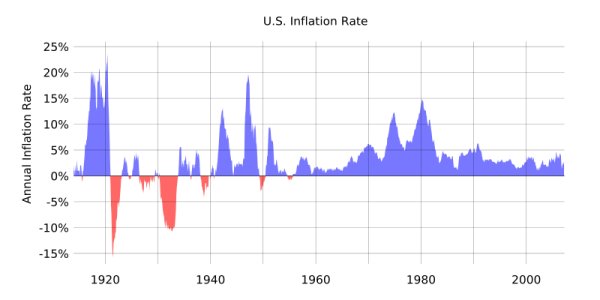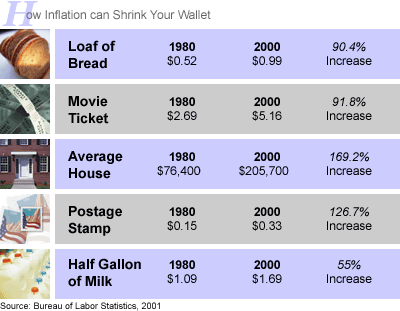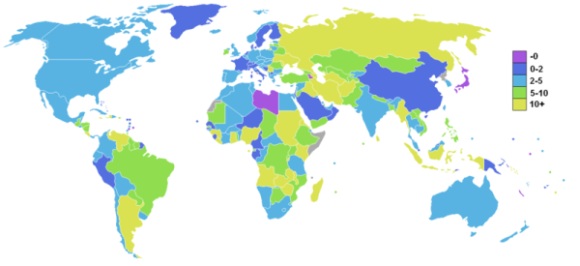“Inflation is when you pay fifteen dollars for the ten dollar haircut you used to get for five dollars when you had hair.” — Sam Ewing

I still remember the “good old days” when gas cost $1.50 a gallon. Heck, if you went further back and looked at how much things cost in 1964 when many of us weren’t born yet, you’d probably think how nice and cheap prices were back then. But at that time, you’d be lucky to make $10,000 a year and more likely to make half of that amount.
Some examples of items in 1964 from the American Heritage Magazine “The Cost of Living” article:
How Much Did Things Cost in 1964?
| | |
| Four-bedroom, two-bath house in South Bend, Indiana | $16,000 |
| “Penthouse view” in doorman building on East 69th Street, Manhattan | $245 per month |
| Hershey chocolate bar | $0.05 |
| Steak dinner at the Palm in Manhattan | $8 |
| Fruit of the Loom boxer shorts | $0.69 |
| Ford Mustang, starting price | $2,358 |
| Rental car, Ford Falcon | $5 per day |
| DeBeers one carat diamond | $500 to $1,800 |
| One year’s tuition at Harvard | $2,400 |
| One year’s tuition at Syracuse University | $750 |
| Ticket to “Goldfinger” with Sean Connery | $1 |
Fast forward to today…
Today, with $9 or $10 for a movie ticket, property values in South Bend, Indiana at $126,000, Manhattan rents at $4,000 a month and Harvard tuition at over $31,000 a year, we have come to accept these price increases as part of everyday living, since after all, our median $53,350 a year salary is going to cover our expenses accordingly. In fact, we shouldn’t really complain too much with our inflation rates holding low for so long.
In general though, inflation is something we accept grudgingly as part of our daily life. Though price increases can be wrongly attributed to greedy capitalists and businesses, for the most part, price hikes happen because of less self-serving reasons. Here are some of the most common reasons for higher prices:
Why Do We Get Price Hikes?
#1 Increase in money supply
One of the most common reasons for prices increases is that the government raises our money supply or releases more currency in circulation, which then cause businesses to increase prices to maintain the same value for their products.
#2 Scarcity of products
High demand chasing low supply (or scarcity) can also cause price increases: when food items such as oranges or grapes are negatively affected by weather, then we see the consequences in our grocery stores.
#3 Interest rates
Higher interest rates can cause borrowing and the cost of doing business to become more expensive — we may see that cost passed on to general products and services. To be specific, a higher interest rate environment may be inflationary in the short term, but in the long term, rates are raised to counter inflation. Lower interest rates can spur growth and potentially inflation as well.
Graphic Displays of Inflation
So far, inflation has been tame in the United States, and we can thank the Federal Reserve hawks Bernanke and Greenspan for this. In fact, some mild inflation is actually considered a benefit by some economists and business people who believe it “greases the wheels of commerce”. The important thing is that it remains in check. If you check out this U.S. historical inflation chart, we’ve never had more stable prices than we do today.

Let’s just be thankful we don’t have to face runaway inflation as the Zimbabweans are doing at this point in time, where they are dealing with prices, incomes and money supplies that are out of control. Nor do we have to worry about deflation, which is the sustained fall in prices, typically triggered by a decrease in demand. That’s something the Fed keeps an eye on as well. In general though, by looking at this world inflation chart, it looks like we’re relatively in good shape.
Now there are some “chicken littles” out there who thrive on gloomy predictions about our future economic situation, who present arguments that show the huge slide of the dollar’s purchasing power, while hyping up the ultimate safe haven that is gold and precious metals. All I can say to that is, don’t get too carried away — see all sides of the story behind rising prices. Try these tools out for fun:
Playing With Prices: Use These Interactive Resources
If you’re ever in the mood to delve into the historical movement of money and prices, then here are some things I found around the internet that pertain to this topic:
Cool Inflation Calculators
I discovered these cool calculators that shows us how our dollars have kept up with time: how does a certain dollar amount change from one year to another based on inflationary effects? You’ll find it with this tool, or this one.
Consumer Price Index Surveys
If you’re curious to see what the history of price is for a particular item from 1978 through today, here’s something you can review. I’m just surprised that bananas haven’t really changed in price much for the last 10 years, whereas other goods like eggs and milk have! More price index information here.
Percentage Increase in Prices of Ordinary Goods
Following is another illustration that shows you the percentage increase in prices for some common items we buy. In the span of a mere couple of decades, we see percentage rate increases from 55% for milk to 170% for your average house. What a difference 20 years makes!

Though prices go up, we may not notice the increase when we get raises, relatively fatter salaries, and appreciated assets. When we see how everything else goes up, including our income, it isn’t as bad as it appears.
Customizable Inflation Charts
Check out these customizable, historical inflation charts for the United States and the rest of the world. Before trying out a new entry, make sure you reset or clear out your previous entry for the graphs to work. Presently, U.S. inflation rates are a little over 2% while global inflation rates are even lower.
More Tools and Sources Covering the Value of Money
Visit this web site and you’ll see a whole slew of information that touch on the value of old money, history, facts and figures that span the world. It contains a vast collection of money and currency data.
In general, low inflation through the years is something we barely care about on a daily basis. Many of us get raises that keep up with the cost of living. But in the long term, these cost of living changes WILL matter. And it’s especially harder for people on fixed income. The good news, though, is that there are ways to combat the gradual degradation of your money’s value, but you’ll need to stay tuned for another post to continue this discussion.
source: thedigeratilife.com
Fort Lauderdale Real Estate Blog & Homes For Sale
Rory Vanucchi
RoryVanucchi@gmail.com



